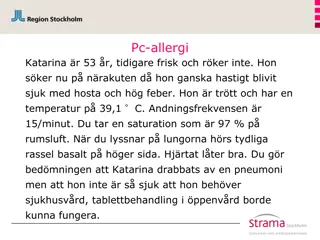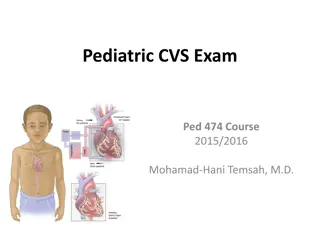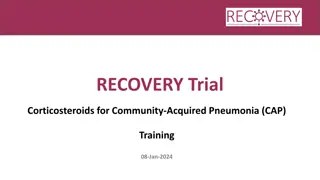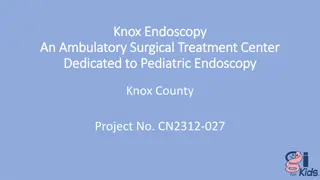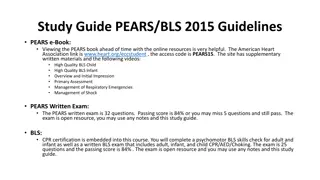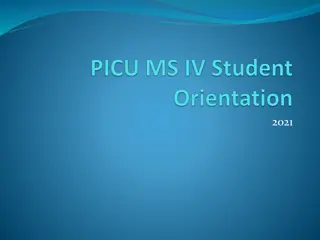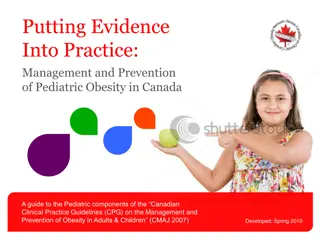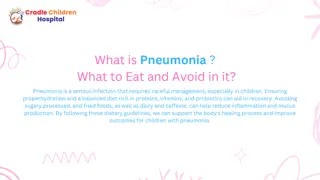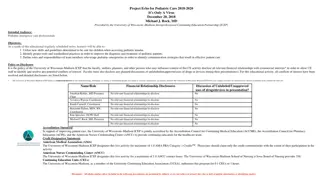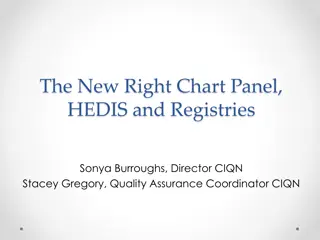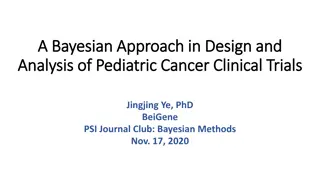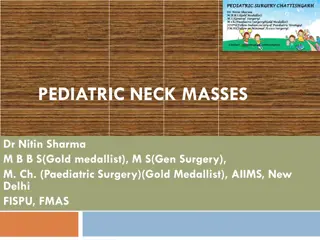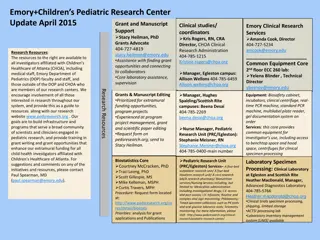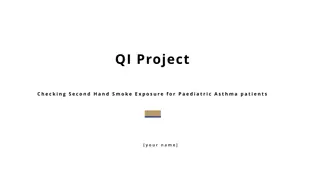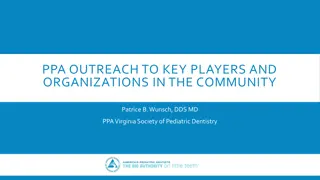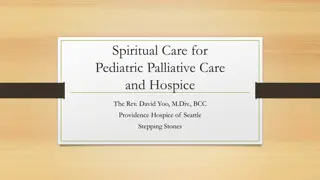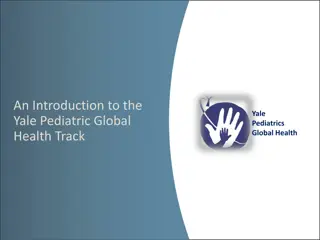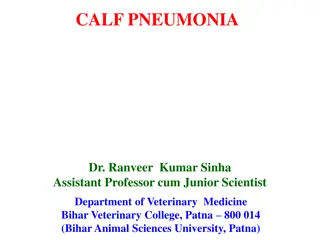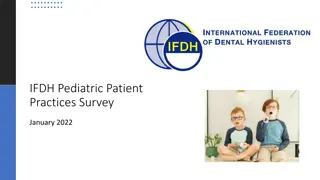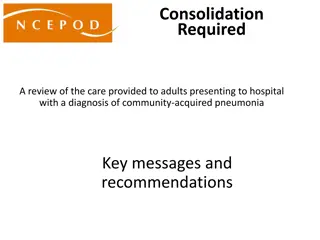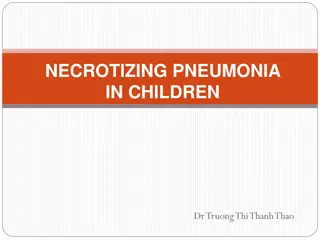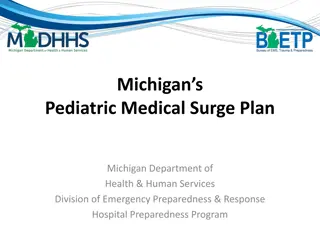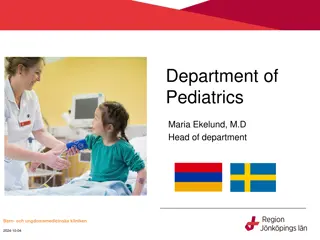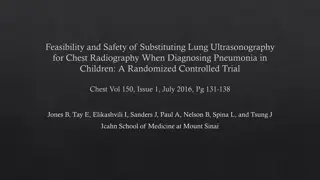Pediatric Workforce Initiative 2025 Presentation Highlights
Explore the key points of the Pediatrics 2025 AMSPDC Workforce Initiative, emphasizing the importance of investing in pediatric health care, the role of pediatric subspecialists, and the need for improved access to specialized care for children and adolescents. The presentation covers reasons to pri
2 views • 28 slides
Pediatric Trauma Resources: Chest, Abdomen, and Pelvis Review
This guideline provides resources for the evaluation and management of chest, abdomen, and pelvic trauma in pediatric patients. It covers a range of topics including thoracic injuries, abdominal trauma evaluation, nonoperative management protocols, and guidelines for various pediatric injuries. The
4 views • 21 slides
Evaluation and Treatment for Pneumonia in Patient with Penicillin Allergy
A 53-year-old woman, Katarina, presents with sudden illness of cough, high fever, and fatigue. With signs of pneumonia, but allergic to penicillin, the decision involves choosing appropriate treatment options such as PcV and considering past allergic reactions and infection history. Evaluating poten
3 views • 20 slides
Nursing Care for Ventilator-Associated Pneumonia (VAP)
Ventilator-Associated Pneumonia (VAP) is defined as lung parenchyma inflammation occurring 48 hours or more after endotracheal intubation and mechanical ventilation initiation. It is a common nosocomial infection in ICU patients, with significant morbidity and mortality rates. Etiology of VAP involv
2 views • 24 slides
Pediatric Cardiovascular Exam Overview
Explore the differences between pediatric and adult cardiovascular exams, highlighting key differences in disease patterns, examination approaches, and objectives. Learn about the importance of distinguishing between routine well-baby exams and evaluations of ill children, along with step-by-step gu
5 views • 24 slides
Understanding Pneumonia: Causes, Classification, and Risk Factors
Pneumonia is an infection of the lower respiratory tract that can be classified anatomically and etiologically. The common causes include bacterial, viral, and fungal pathogens, as well as aspiration pneumonia. Factors such as immune deficiency, overcrowding, and poor hygiene can increase the risk o
10 views • 37 slides
Trusted Partner in Pediatric Wellness is Our QuickMD Care - Google Docs
Quickmdcare-Pediatrician Doctors provides a wide range of Pediatric services in Pediatric hospital at Frisco, Mckinney, Texas. Pediatric Doctors Clinic.
6 views • 1 slides
RECOVERY Trial: Corticosteroids for Community-Acquired Pneumonia (CAP) - Overview and Eligibility Criteria
Community-Acquired Pneumonia (CAP) is a common reason for hospitalization globally, with estimated annual fatalities of approximately 2.5 million. The RECOVERY Trial is investigating the use of corticosteroids in patients with CAP suspected or confirmed to be of bacterial origin. Eligibility criteri
1 views • 13 slides
Pediatric Lead Prevention Initiative: Best Practices and Screening Performance
This initiative focuses on lead screening in pediatric patients, emphasizing the importance of testing due to the absence of a safe lead level. The program aims to improve compliance with lead testing regulations, including Medi-Cal mandates, and introduce new clinical measures for lead screening. I
1 views • 18 slides
Enhancing Pediatric Endoscopy Services at Knox County
Knox Endoscopy, dedicated to pediatric endoscopy, faces a growing caseload demanding additional capacity. Existing facilities are at optimal utilization levels, prompting the proposal of a cost-effective Ambulatory Surgical Treatment Center (ASTC). The proposed ASTC is expected to be a more efficien
0 views • 9 slides
Elevator Pitch for Pediatric Champions
Elevator speech helps in defining and communicating the value proposition of a project efficiently. In the context of developing a pediatric champion role, this pitch emphasizes the significance of having a dedicated staff member focused on pediatric readiness, highlighting the need for improved pra
0 views • 5 slides
Pediatric Emergency Assessment and Resuscitation Study Guide
Study Guide for PEARS/BLS 2015 Guidelines covers key topics such as initial assessment, pediatric respiratory emergencies, shock management, and CPR certification. Access online resources and videos for better preparation. Learn about PEARS systematic approach algorithm, hypotensive shock criteria,
0 views • 9 slides
Introduction to Pediatric Intensive Care Unit (PICU) Guidelines
Welcome to the Pediatric Intensive Care Unit (PICU)! This comprehensive document outlines the daily schedule, clinical expectations, COVID-19 safety protocols, overnight call responsibilities, and student duties in the PICU setting. Learn about the demanding yet rewarding environment where you'll ha
0 views • 22 slides
Understanding Thickened Liquids in Dysphagia Management
Thickened liquids are often recommended for residents with swallowing difficulties to prevent aspiration pneumonia. Recommendations are typically made by speech pathologists, with nursing sometimes adjusting based on availability of therapy. Aspiration pneumonia occurs when substances are inhaled in
1 views • 33 slides
Pediatric Obesity Management and Prevention Guidelines in Canada
This resource provides guidance on pediatric obesity management and prevention in Canada, based on the Canadian Clinical Practice Guidelines. It includes recommendations specific to the pediatric population, implementation strategies, and insights from content experts. The slides cover a range of to
1 views • 66 slides
Pediatric Dental Crown and Root Fractures Management Guidelines
Guidelines for managing pediatric dental crown and root fractures are provided based on the type and severity of the fracture, along with treatment recommendations, follow-up schedules, and parent/patient education tips. The content covers uncomplicated crown fracture, primary tooth enamel-dentine f
2 views • 9 slides
What is Pneumonia What to Eat and Avoid in it
Pneumonia is a serious infection that requires careful management, especially in children. Ensuring properhydration and a balanced diet rich in proteins, vitamins, and probiotics can aid in recovery
0 views • 7 slides
Guidelines for Management of Pediatric Venous Thromboembolism
This educational slide set presents the American Society of Hematology's 2018 guidelines for the treatment of pediatric venous thromboembolism. The guidelines cover various aspects such as prevention, treatment, and optimal management of anticoagulation therapy in pediatric patients. Panels were for
0 views • 47 slides
Pediatric Care Educational Program: Project Echo 2018-2020
Enhance pediatric emergency care skills and guidelines through the Project Echo educational series led by Dr. Michael J. Rock, MD. This program focuses on improving diagnosis, treatment, and communication strategies for pediatric trauma cases. Accredited by various organizations, participants can ea
0 views • 15 slides
Enhancing Pediatric Population Health with CIQN's Initiatives
CIQN's Population Health Initiative aims to improve pediatric health through data analytics, registry implementation, and enhanced patient care. With an extensive database, diverse source systems, and comprehensive pediatric registries, CIQN focuses on reducing costs while promoting better health ou
0 views • 21 slides
Bayesian Approach in Pediatric Cancer Clinical Trials
Pediatric cancer clinical trials benefit from Bayesian analysis, allowing for the incorporation of uncertainty in prior knowledge and ensuring more informed decision-making. The use of Bayesian methods in the development of cancer drugs for children and adolescents, as emphasized by initiatives like
0 views • 26 slides
Pediatric Neck Masses: Causes and Anatomy Explained by Dr. Nitin Sharma
Learn about pediatric neck masses, their causes including congenital, inflammatory, and malignant factors, and the embryology and anatomy behind them. Detailed insights are provided on the branchial system, its arches, pouches, and the structures they contribute to in the neck. Dr. Nitin Sharma, a h
0 views • 42 slides
Pioneering Pediatric Transplantation Initiatives
In the realm of pediatric transplantation, recent projects and upcoming bylaw implementations are focused on enhancing care transition, establishing key personnel requirements, and implementing vital components for kidney, liver, heart, lung, and pancreas transplants. The initiatives aim to improve
0 views • 9 slides
Emory Children's Pediatric Research Center Update
Emory Children's Pediatric Research Center provides grant and manuscript support, assistance in finding grant opportunities, connecting with collaborators, and access to common equipment and services for pediatric researchers affiliated with Children's Healthcare of Atlanta. The center aims to enhan
0 views • 15 slides
Improving Pediatric Asthma Care Through Second-Hand Smoke Exposure Assessment
Data from GP practices in Wales indicate a low rate of discussing second-hand smoke exposure with pediatric asthma patients. This Quality Improvement (QI) project aims to ensure systematic identification and advice provision for patients exposed to second-hand smoke during asthma reviews. The propos
0 views • 6 slides
Pediatric Dentistry Advocacy Initiatives in Virginia
Key players and organizations in the community, including Dr. Patrice B. Wunsch, DDS, MD, are actively involved in outreach efforts at the state and national levels to advocate for pediatric dentistry in Virginia. Initiatives range from lobbying for Medicaid deferment options and expansion to addres
0 views • 13 slides
Pediatric Spiritual Care in Palliative Settings: Insights from Providence Hospice
Explore the nuances of providing spiritual care in pediatric palliative settings through the lens of The Rev. David Yoo at Providence Hospice of Seattle. Learn about the unique themes, challenges, and approaches involved in supporting children and their families facing serious illnesses. Gain insigh
0 views • 10 slides
Yale Pediatric Global Health Track Overview
The Yale Pediatric Global Health Track aims to equip pediatric residents with the skills and understanding necessary to address child health inequities globally. Residents gain exposure to core health disparity principles, ethical global health principles, and major causes of childhood morbidity. Th
0 views • 13 slides
Integrative Approaches to Pediatric Pain Management: A Comprehensive Review
Pediatric pain management is a complex issue involving factors such as inflammation, neuroplasticity, and emotional responses. Dr. Matthew Hand explores integrative approaches to address common pediatric pain conditions and highlights the prevalence of chronic pain in children. The presentation delv
0 views • 39 slides
Understanding Calf Pneumonia: Symptoms, Treatment, and Consequences
Calf pneumonia is a significant disease in calves aged one to five months. It is essential to diagnose, treat, and prevent this multifactorial disease for the cattle industry. With types, causes, symptoms, and consequences discussed in detail, the content also covers treatment options like antibioti
0 views • 13 slides
IFDH Pediatric Patient Practices Survey January 2022
Survey conducted by IFDH in January 2022 to understand the practices of dental hygienists with pediatric patients aged 6 to 12. The survey gathered responses from 367 participants across 25 countries, with a focus on demographics, work settings, educational backgrounds, and frequency of seeing pedia
0 views • 19 slides
Pediatric Palliative Care and the Role of Interlink Nurses in Northern Ontario
Vicky Wilton, a Pediatric Interlink Nurse in Northern Ontario, presented on pediatric palliative care focusing on identifying differences and similarities between pediatric and adult care, integrating advance care planning, and emphasizing hope. The role of Pediatric Interlink Nurses within the Pedi
0 views • 69 slides
Review of Care for Adults with Community-Acquired Pneumonia
This review focuses on the care provided to adults diagnosed with community-acquired pneumonia (CAP) in hospitals. Key findings include the importance of accurate diagnosis, clinical decision making, and antibiotic management. The study assessed the quality of care through various questionnaires and
0 views • 23 slides
Overview of Necrotizing Pneumonia in Children
Necrotizing pneumonia in children is characterized by necrosis of pulmonary tissue, leading to the formation of small cavities containing necrotic debris or fluid. Staphylococcus Aureus and Streptococcus Pneumoniae are common pathogens. Treatment involves a prolonged course of IV antibiotics tailore
0 views • 34 slides
Antibiotics in Action: Pneumonia Management with Ceftriaxone
Dr. Alyssa Castillo presents strategic antibiotic selection tools for common infections like pneumonia, UTI, and cellulitis, focusing on frequently utilized antibiotics like ceftriaxone. The case study explores treating a 55-year-old pneumonia patient with IV ceftriaxone and discusses additional ant
0 views • 55 slides
Michigan Pediatric Medical Surge Plan Overview
The Michigan Statewide Pediatric Steering Committee has developed a framework for the Pediatric Medical Surge Plan, with ongoing work needed for review and updates. The plan aims to guide medical care provision for children during disasters, involving various stakeholders and following defined traum
0 views • 18 slides
Pediatric Respiratory Infections: An Overview of Cases and Physiology
This review delves into selected cases of respiratory infections in children presented by Dr. David L. Smith, focusing on the anatomical and physiological aspects of the pediatric airway and respiratory system. It discusses respiratory failure in infants and small children, metabolic demands, cyanos
0 views • 49 slides
Understanding Hospital-Acquired Pneumonia: Epidemiology, Etiology, Diagnosis & Treatment
Hospital-acquired pneumonia is a serious infection occurring at least 2 days after hospital admission, leading to complications and mortality. It can be classified into VAP and HCAP, with various predisposing factors and microbiological causes. Recognizing clinical features and prompt treatment are
0 views • 29 slides
Pediatric Department at Barn-och Ungdomsmedicinska Kliniken - Providing Specialized Care for Children
The Department of Pediatrics at Barn-och Ungdomsmedicinska Kliniken, led by Dr. Maria Ekelund, focuses on providing specialized outpatient and inpatient care for pediatric patients, including newborns. Their mission is to be a knowledge center for children's healthcare, with two wards, a neonatal wa
0 views • 27 slides
Utility of Lung Ultrasonography in Pediatric Pneumonia Diagnosis
Pneumonia, a leading cause of pediatric mortality globally, presents diagnostic challenges as history and physical exams may not reliably differentiate viral lung infections from bacterial pneumonia. This study explores the feasibility and safety of substituting lung ultrasonography (LUS) for chest
0 views • 21 slides


